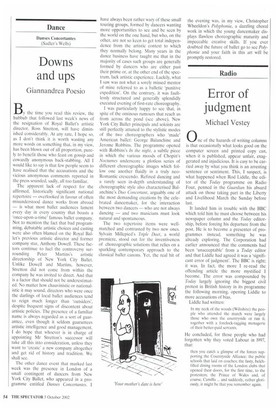Downs and ups
Giannandrea Poesio
By the time you read this review, the hubbub that followed last week's news of the resignation of Royal Ballet's artistic director, Ross Stretton, will have diminished considerably. At any rate, I hope so, as I don't think it is worth wasting any more words on something that, in my view, has been blown out of all proportion, purely to benefit those who feast on gossip and cowardly anonymous back-stabbing. All I would like to say is that few people seem to have realised that the accusations and the vicious anonymous comments reported in the press sounded, sadly, all too familiar.
The apparent lack of respect for the affirmed, historically significant national repertoire — overlooked in favour of often misunderstood dance works from abroad — is what most ballet audiences lament every day in every country that boasts a 'once-upon-a-time' famous ballet company. Not to mention the fact that bad programming, debatable artistic choices and casting were also often blamed on the Royal Ballet's previous artistic director and former company star, Anthony Dowell. These factors continue to fuel the controversy sur
rounding Peter Martins's artistic directorship of New York City Ballet. Unlike Dowell and Martins, however, Stretton did not come from within the company he was invited to direct. And that is a factor that should not be underestimated. No matter how chauvinistic or nationalistic it may sound, directors who were once the darlings of local ballet audiences tend to reign much longer than 'outsiders', despite frequent signs of discontent about artistic policies. The presence of a familiar name is always regarded as a sort of guarantee, even though it seldom guarantees artistic intelligence and good management. I do hope that whoever is in charge of appointing Mr Stretton's successor will take all this into consideration, unless they want to 'createa new company altogether and get rid of history and tradition. We shall see.
The other dance event that marked last week was the presence in London of a small contingent of dancers from New York City Ballet, who appeared in a programme entitled Danses Concertantes, I
have always been rather wary of these small touring groups, formed by dancers wanting more opportunities to see and be seen by the world on the one hand, but who, on the other, are not so keen to get total independence from the artistic context to which they normally belong. Many years in the dance business have taught me that in the majority of cases such groups are generally formed by dancers who are either past their prime or, at the other end of the spectrum, lack artistic experience. Luckily, what I saw was not what a sorely missed mentor of mine referred to as a balletic 'punitive expedition'. On the contrary, it was faultlessly structured and generally splendidly executed evening of first-rate choreography.
I was particularly happy to see that, in spite of the ominous rumours that reach us from across the pond (see above), New York City Ballet principals and soloists are still perfectly attuned to the stylistic modes of the two choreographers who 'made' American ballet: George Balanchine and Jerome Robbins. The programme opened with Robbins's In the night, a subtle piece in which the various moods of Chopin's Nocturnes underscore a plotless series of different choreographic images which follow one another fluidly in a truly neoRomantic crescendo. Refined dancing and a rarely seen in-depth understanding of choreographic style also characterised Balanchine's Duo Concertant, arguably one of the most demanding creations by the celebrated dancemaker, for the interaction between two dancers — who are not always dancing — and two musicians must look natural and spontaneous.
The two repertoire items were wellmatched and contrasted by two new ones. Sylvain Millepied's Triple Duet, a world premiere, stood out for the inventiveness of choreographic solutions that relies on a sparkling contemporary approach to the classical ballet canons. Yet, the real hit of
the evening was, in my view, Christopher Wheeldon's Polyphonia, a dazzling choral work in which the young dancemaker displays flawless choreographic maturity and impeccable creative skills. If you ever doubted the future of ballet go to see Polyphonia and your faith in this art will be promptly restored.




































































 Previous page
Previous page